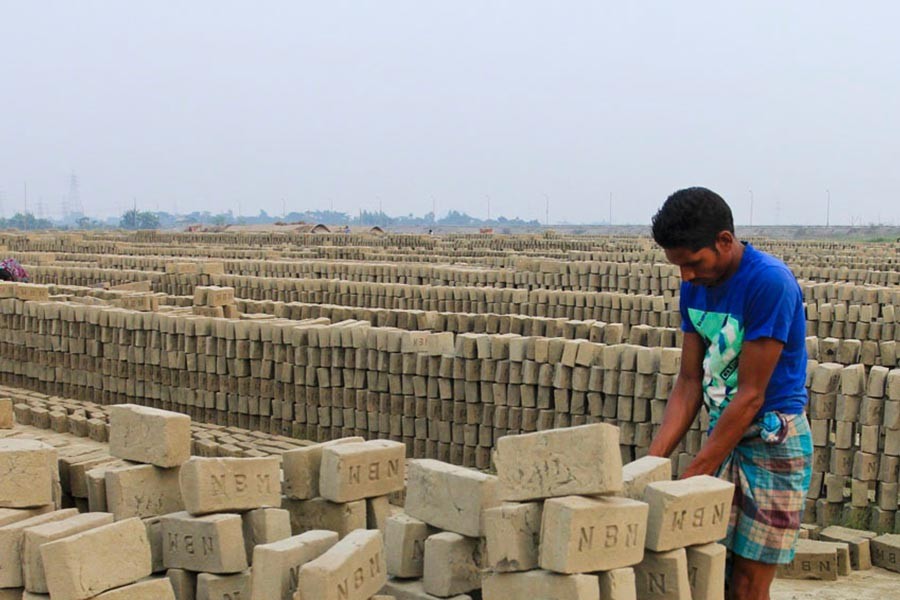
Published :
Updated :

There is hardly any argument that among the many hazards affecting the environment, brick making is one that not only adversely affects the ecosystem but more significantly leaves a ruinous impact on a host of livelihood means of the masses, notably among others cultivation. This is particularly so when it comes to conventional brick making practices in the country for ages. Occasional reports in the newspapers and alarm raised by environmentalists have, in effect, done very little to rein in the menacing growth of brick making all over the country. However, it must not be denied that the government's enactment of the brick making law a few years ago may have been prompted by these reports and worries voiced by social and environmental activists. With the law in place, one has reasons to believe that things are set to change for the better.
Sadly, this has not happened yet. Emergence of brick kilns irrespective of locations has been on the rise for decades, facilitated largely by the absence of any enforceable rules. This is not to say there was no law governing brick making. The Brick Burning (control) Act 1989 had its inadequacies to dictate terms in the first place, and besides, lacuna in the enforcement of some of the compliance issues made things worse. Resultantly, the practice of setting up brick plants at any location of choice went unopposed.
The law currently in force apparently addresses the core issues associated with brick making-- meant chiefly to check widespread environment pollution as well as save arable land and forest. The law 'Brick Making and Brickfield Establishment (Control) Act 2013' has brought tough regulations for brick production that among others provides for trial for offences under the penal code. The stipulations envisaged in the law apply to all brick kilns in the country. The law prohibits establishment of brick kilns in residential, protected, commercial and agricultural locations, and also in forests, sanctuaries, wetlands and ecologically critical areas.
According to the Department of Environment, there are well over 6,000 brickfields in the country. However, environmentalists claim the number to be as high as around 10,000, and half of them are located around the capital Dhaka. According to a UNDP estimate, Bangladesh produces some 8.66 billion bricks a year valued at $450 million -- almost 1.0 per cent of the country's GDP. Despite the sizeable contribution of brick making to the economy, one of the grim realities is that brick fields all over the country are getting increasingly invasive in grabbing the country's less than sufficient arable lands. More dangerous is the threat that comes in terms of affecting neighbourhood lands under cultivation because of the heat, caustic smoke and dust generated by the brick making plants. A local daily reports that over 6.4 million tonnes of carbon emissions are caused by the brick kilns annually.
As things are going unabated despite the law in force, it is clear that mere formulation of the law didn't help-- although the law was a foremost necessity and it did take a lot of things to work on. If not enforced in the right spirit, a law is no more than expression of intent. The job, no doubt, is challenging given the vast swathes of land, mostly agricultural, occupied by brick making plants. Disciplining these in line with the law is one thing, and setting up new plants is another. The law does not categorically mention relocation or phasing out of the outmoded plants from the prohibited areas. On the other hand, there should have been clear guidelines in the law for setting up of new plants adopting green technology.
Concerned quarters are of the opinion that alongside the law taking its course, there is the need to introduce modern green technology capable of taking care of the pollution aspect to a great extent. A UNDP funded project "Green Brick" was initiated in 2010 to introduce modern technology to the country's brick making industry with a shift to greener kilns that experts believe could halve the industry's carbon emissions. It has been learnt that the popular and widely accepted technology in this regard is smokeless, energy efficient Hybrid Hoffman Kiln (HHF) that the Green Brick project is going to introduce in the country. It has been gathered that the HHF brick kilns can burn most of the fuel used during firing. This also results in lesser energy use and a considerable cut on production costs. The most notable aspect of the technology is that it dries the bricks by directing hot air into the tunnel from the kiln, which blocks carbon emissions.
In view of the wide acceptance of the technology in advanced countries chiefly because of its emission-preventing device, Bangladesh should have opted for it long back. The cost of the technology is reportedly high. But keeping in view its efficiency, cost-effectiveness, high scale of production and above all emission-free mechanism, it is highly imperative that the government gradually phased out the traditional kilns, and provided necessary support by way of soft-term financing to encourage the green technology.


 For all latest news, follow The Financial Express Google News channel.
For all latest news, follow The Financial Express Google News channel.